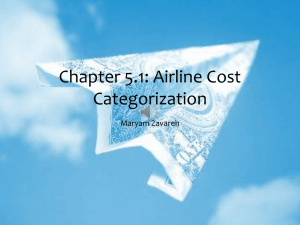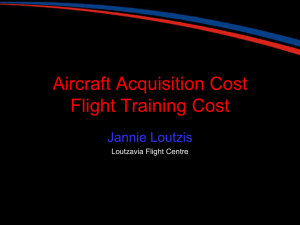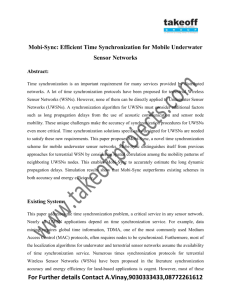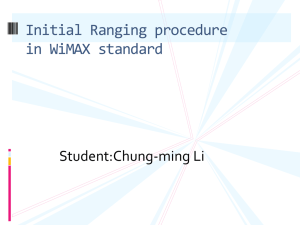Chris Dimoulis
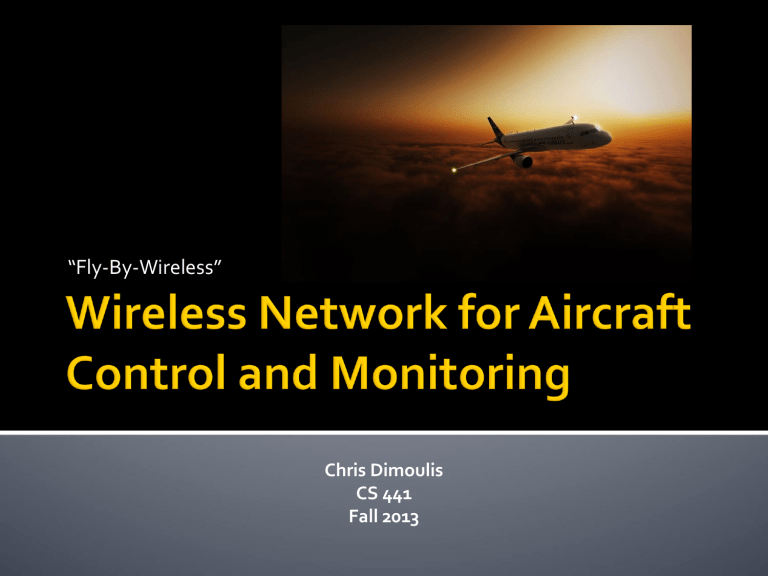
“Fly-By-Wireless”
Chris Dimoulis
CS 441
Fall 2013
Aircraft Systems (Current)
Benefits of Wireless System
Characteristics and Obstacles
Proposed Solutions
Cables and Pulleys
Direct connection from flight controls to control surface
Hydraulic
Direct manipulation of hydraulic actuators in flight controls
Fly-By-Wire
Avionics Full Duplex Switched Ethernet (AFDX) used to send data from controls to actuators
View and manipulate flight and engine data\
Old Systems
Pressure systems for altitude and airspeed
Mechanical linkages for engine data (tachometer and manifold pressure)
New Systems
Full Authority Digital Engine Control (FADEC)
Automatically controls engine parameters, sends data to pilots through AFDX
Cost from Weight Reduction
Cable costs: A320: $14M B787: $50M [1]
A380: 300 miles (500 km) of wire [2]
Weight reduction means better fuel efficiency and increased space for revenue weight
Improved Safety and Less Maintenance
Less Wire degradation
U.S. Navy: 78 aircraft made non-mission capable due to wiring, 1000 aborts from wiring faults [2]
Wired interconnects and potential fires
▪ B 747 tank explosion due to arcing between fuel sensor wiring [3]
Real-Time and Deterministic [1]
Aircraft Network must behave in a predictable way
Current system provides 100Mbps
Latencies must be bounded and deadline constraints respected
Reliability and Availability
Probability of failure needs to be 10 -9 per flight hour [1]
Fault Detection
Long lifetime: Avionics system lifetime can be 20
– 30 years [1]
Security [1]
Data confidentiality to prevent passive eavesdropping
Data integrity to guarantee data is not altered in transit
Prevent unauthorized access to network
Electromagnetic Compatibility [1]
Deployment is in a harsh physical environment
Large temperature and humidity changes along with vibrations
Intense radio frequency noise
Table reproduced from [1]
802.11n
+ Adequate Data rate
+ Uses Point Coordination Function for contention free mode
-
-
+ Reliability: Automatic Retransmission ReQuest
(ARQ )
Not adapted for multicast [1]
High possibility of interference from common devices [1]
ECMA-368 High Rate Ultra WideBand
+ Adequate Data rate and ranges
+ Distributed Reservation Protocol
TDMA (Contention free)
+ More secure from “man-in-middle” than 802.11
Begin with a hybrid system
Full Duplex Ethernet Switch to connect clusters
Image reproduced from [1]
MAC Protocol Proposals
Need predictable behavior under real-time constraints
▪ Synchronization protocol for TDMA
Reliability Mechanism for sending/receiving data
▪ Probability of failure to be 10 -9 per flight hour
Synchronization Protocol
IEEE1588 Wired network synchronization have been implemented within few nanoseconds precision
IEEE1558 has reached less than 200 nanosecond precision for wireless network synchronization, however too many messages
Proposed enhanced IEEE1588
Synchronization Protocol
Master/Slave/Passive node
If slave node fails passive node can fill in
Image reproduced from [1]
Reliability Mechanism
Need adequate acknowledgement and retransmission mechanism
Communication is multicast
▪ Multiple ACKs colliding?
▪ Overhead from sender needing to receive all ACKs
Reliability Mechanism
Designated “leader” of cluster
ACK from leader, NACK from rest
If sender hears NACK or nothing (due to
ACK/NACK collision) then it will retransmit
Image reproduced from [1]
ECMA-368 can provide adequate data rate, contention free, and security properties
Needs predictable real-time behavior
Enhanced IEEE1588 synchronization
Reliable data reception
Cluster leaders with ACK/NACK messages
[1] D. Dang, A. Mifdaoui,and T. Gayraund, “Fly-By-Wireless for Next
Generation Aircraft: Challenges and Potential solutions.” (In Press: 2012)
In: Wireless days conference, 21-23 Nov 2012, Dublin, Ireland
[2] R. K. Yedavalli, R. K. Belapurkar, “Application of Wireless Sensor
Networks to Aircraft Control and Health Management.” Journal of control
Theory & Applications. February 2011; 9(1):28.
[3] M. Panitz, D. Hope, W. Crowther, et al. “The opportunities and challenges associated with wireless interconnects in aircraft.” Proceedings Of The
Institution Of Mechanical Engineers -- Part G -- Journal Of Aerospace
Engineering (Sage Publications, Ltd.) [serial online]. April 2010;224(4):459.






